Related Research Articles

The lorica segmentata, also called lorica lamminata, is a type of personal armour that was used by soldiers of the Roman Empire, consisting of metal strips fashioned into circular bands, fastened to internal leather straps. The lorica segmentata has come to be viewed as iconic of the Roman legions in popular culture. The tendency to portray Roman legionaries clad in this type of armour often extends to periods of time that are too early or too late in history.
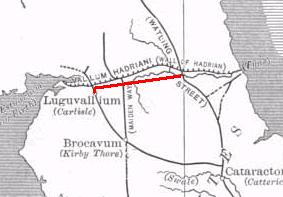
The Stanegate was an important Roman road built in what is now northern England. It linked many forts including two that guarded important river crossings: Corstopitum (Corbridge) on the River Tyne in the east, and situated on Dere Street, and Luguvalium (Carlisle) on the River Eden in the west. The Stanegate ran through the natural gap formed by the valleys of the River Tyne in Northumberland and the River Irthing in Cumbria. It predated Hadrian's Wall by several decades; the Wall would later follow a similar route, slightly to the north.

Corbridge is a village in Northumberland, England, 16 miles (26 km) west of Newcastle and 4 miles (6 km) east of Hexham. Villages nearby include Halton, Acomb, Aydon and Sandhoe.

Roman roads in Britannia were initially designed for military use, created by the Roman Army during the nearly four centuries (AD 43–410) that Britannia was a province of the Roman Empire.

The Brigantes were Ancient Britons who in pre-Roman times controlled the largest section of what would become Northern England. Their territory, often referred to as Brigantia, was centred in what was later known as Yorkshire. The Greek geographer Ptolemy named the Brigantes as a people in Ireland also, where they could be found around what is now Wexford, Kilkenny and Waterford, while another people named Brigantii is mentioned by Strabo as a sub-tribe of the Vindelici in the region of the Alps.
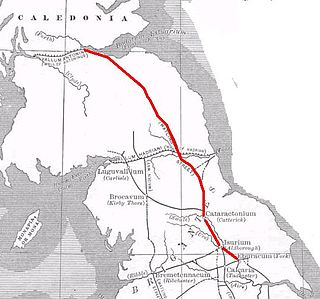
Dere Street or Deere Street is a modern designation of a Roman road which ran north from Eboracum (York), crossing the Stanegate at Corbridge and continuing beyond into what is now Scotland, later at least as far as the Antonine Wall. Portions of its route are still followed by modern roads, including the A1, the B6275 road through Piercebridge, where Dere Street crosses the River Tees, and the A68 north of Corbridge in Northumberland.
The names of the Celtic Iron Age tribes in Britain were recorded by Roman and Greek historians and geographers, especially Ptolemy. Information from the distribution of Celtic coins has also shed light on the extents of the territories of the various groups that occupied the island.

Corbridge is a railway station on the Tyne Valley Line, which runs between Newcastle and Carlisle via Hexham. The station, situated 19 miles 15 chains west of Newcastle, serves the village of Corbridge in Northumberland, England. It is owned by Network Rail and managed by Northern Trains.
Coria may refer to:

The Corbridge Lion, Northumberland, England, is an ancient Roman free-standing sandstone sculpture of a male lion standing on a prone animal on a semi-cylindrical coping stone base. Measuring 0.95m in length by 0.36m in width and 0.87m high, it was originally a piece of decorative funerary ornamentation from a tomb. It was subsequently re-used as a fountainhead by passing a water pipe through its mouth. It was found in a water tank in 1907 in excavations led by Leonard Woolley on Site II on the Roman site at Corbridge. It is believed to date to the 2nd or 3rd centuries AD.
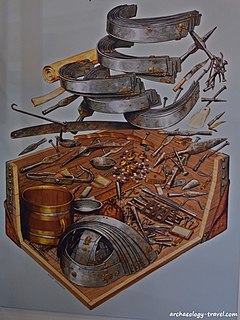
The Corbridge Hoard is a hoard of mostly iron artefacts that was excavated in 1964 within the Roman site of Coria, next to what is now Corbridge, Northumberland, England.

Coria was a fort and town 2.5 miles (4.0 km) south of Hadrian's Wall, in the Roman province of Britannia at a point where a big Roman north–south road bridged the River Tyne and met another Roman road (Stanegate), which ran east–west between Coria and Luguvalium in the Solway Plain. The full Latin name is uncertain. In English, it is known as Corchester or Corbridge Roman Site as it sits on the edge of the village of Corbridge in the English county of Northumberland. It is in the guardianship of English Heritage and is partially exposed as a visitor attraction, including a site museum.

A lanx was a large ancient Roman serving platter. Particularly ornamented ones were used to make offerings or sacrifices. Indeed, the silver Corbridge Lanx, the second discovered in Britain, has depicted on it a lanx itself, set beside various gods and goddesses - Minerva, Diana, Juno, Vesta and Apollo.
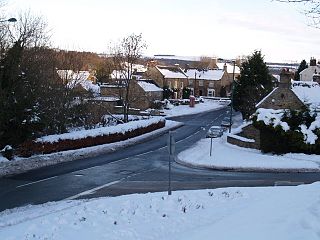
Vindomora was an auxiliary fort on Dere Street, in the province of Lower Britain. Its ruins, now known as Ebchester Roman Fort, are situated at Ebchester in the English county of Durham, to the north of Consett and 12 miles (19 km) west-south-west from Newcastle upon Tyne.
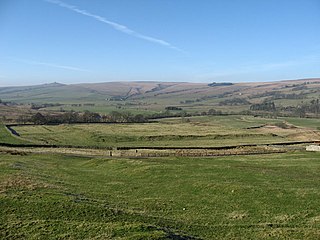
Habitancum was an ancient Roman fort (castrum) located at Risingham, Northumberland, England. The fort was one of the defensive structures built along Dere Street, a Roman road running from York to Corbridge and onwards to Melrose.

The Portgate was a fortified gateway, constructed as part of Hadrian's Wall where it crossed the Roman road now known as Dere Street, which preceded Hadrian's Wall by around 50 years. It was built to control traffic along Dere Street as it passed north through Hadrian's Wall. The gate's remains exist beneath the old B6318 Military Road to the south-west of the Stagshaw Roundabout.

Brian Dobson was an English archaeologist, teacher and scholar. His specialisms were Hadrian's Wall and the Roman Army. He studied under Eric Birley and is a member of the so-called 'Durham School' of archaeology. He was a Reader Emeritus of Durham University.
The Corionototae were a group of Ancient Britons apparently inhabiting what is now Northern England about whom very little is known. They were recorded in one Roman votary inscription from Corbridge, of uncertain date, which commemorated the victory of a prefect of cavalry, Quintus Calpurnius Concessinius, over them.
The Gabrantovices were a conjectural group of Ancient Britons inhabiting the coast of what is now Yorkshire in Northern England. They may have been a sub-tribe or sept of the Brigantes or of the Parisi.

The Corbridge Lanx is the name of a Roman silver dish found near Corbridge, northern England in 1735. Once part of a large Roman treasure, only the silver lanx remains from the original find. The British Museum eventually purchased it in 1993.
References
- ↑ B.C. Burnham & J. S. Wacher, The Small Towns of Roman Britain, University of California Press (1990)